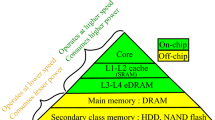Abstract
Error correction code (ECC) and built-in self-repair (BISR) techniques have been widely used for improving the yield and reliability of embedded memories. The targets of these two schemes are transient faults and hard faults, respectively. Recently, ECC is also considered as a promising solution for correcting hard error to further enhance the fabrication yield of memories. However, if the number of faulty bits within a codeword is greater than the protection capability of the adopted ECC scheme, the protection will become void. In order to cure this drawback, efficient logical to physical address remapping techniques are proposed in this paper. The goal is to reconstruct the constituent cells of codewords such that faulty cells can be evenly distributed into different codewords. A heuristic algorithm suitable for built-in implementation is presented for address remapping analysis. The corresponding built-in remapping analysis circuit is then derived. It can be easily integrated into the conventional built-in self-repair (BISR) module. A simulator is developed to evaluate the hardware overhead and repair rate. According to experimental results, the repair rate can be improved significantly with negligible hardware overhead.














Similar content being viewed by others
References
Baumann RC (2001) Soft errors in advanced semiconductor devices-part I: the three radiation sources. IEEE Trans Device Mat Reliability 1(1):17–22
Baumann RC (2005) Radiation-induced soft errors in advanced semiconductor technologies. IEEE Trans on Device and Materials Reliability 5(3):305–316
Chen CW, Wu CW (2010) An adaptive code rate EDAC scheme for 16-bit random access memory. In: Proc. Int’l Conf. Design automation and Test in Europe (DATE), pp. 735–740
Van de Goor AJ, Schanstra I (2002) Address and data scrambling: causes and impact on memory tests. In: Proc. IEEE Int’l Workshop on Electronic Design, Test and Applications, pp. 128–136
Hamming RW (1950) Error detecting and correcting codes. Bell Syst Tech J 29:147–160
Hsiao MY (1970) A class of optimal minimum odd-weight-column SEC-DED codes. IBM J Res Dev 14(4):395–401
Huang CT, Wu CF, Li JF, Wu CW (2003) Built-in redundancy analysis for memory yield improvement. IEEE Trans on Reliability 52(4):386–399
Kang SM, Leblebici Y (2003) CMOS digital integrated circuits: analysis and design. McGraw Hill, New York
Kawagoe T et al (2000) A built-in self-repair analyzer (CRESTA) for embedded DRAMs. In: Proc. Int. Test Conf. (ITC), pp. 567–574
Kim J, Lee W, Cho K, Kang S (2017) Hardware-Efficient Built-In Redundancy Analysis for Memory with Various Spares. IEEE Trans Very Large Scale Integr Syst 25(3):844–856
Kim DH, Milor L (2017) An ECC-Assisted Post package Repair Methodology in Main Memory Systems. IEEE Trans Very Large Scale Integr Syst 25(7):2045–2058
Kuo SY, Fuchs WK (1987) Efficient spare allocation in reconfigurable arrays. IEEE Design and Test of Computers 4(1):24–31
Li J-F, Yeh J-C, Huang R-F, Wu C-W, Tsai P-Y, Hsu A, Chow E (2003) A built-in self-repair scheme for semiconductor memories with 2-D redundancy. Proc. Int. Test Conf. (ITC), Charlotte, pp. 393–402
Li JF et al (2003) A built-in self-repair scheme for semiconductor memories with 2-d redundancy. Proc Int Test Conf (ITC) 1:393–402
Lu SK, Huang HH (2013) Synergistic Reliability and Yield Enhancement Techniques for Embedded Memories. IEEE Trans Computer-Aided Design of Integrated Circuits and Systems 32(1):165–169
Lu SK, Li TL, Ning P (2012) Scrambling and data inversion techniques for yield enhancement of NROM-based ROMs. In: Proc. Asian Test Symposium, pp. 308–313
Lu SK, Tsai TJ, Hashizume M (2016) Enhanced Built-In Self-Repair Techniques for Improving Fabrication Yield and Reliability of Embedded Memories. IEEE Trans Very Large Scale Integr Syst 24(8):2726–2734
Lu SK, Tsai YC, Hsu CH, Kuo-Hua Wang KH, Wu CW (2006) Efficient Built-In Redundancy Analysis for Embedded Memories with 2-D Redundancy. IEEE Trans VLSI Systems 14(1):34–42
Lu SK, Wang ZY, Tsai YM (2012) Efficient Built-In Self-Repair Techniques for Multiple Repairable Embedded RAMs. IEEE Trans Computer-Aided Design of Integrated Circuits and Systems 31(4):620–629
Lu SK et al (2010) Efficient BISR techniques for embedded memories considering cluster faults. IEEE Trans Very Large Scale Integr Syst 18(2):184–193
Maestro JA, Reviriego P (2009) Reliability of single-error correction protected memories. IEEE Trans on Reliability 58(1):193–201
Mayuga G, Yamato Y, Yoneda T, Sato Y, Inoue M (2016) Reliability Enhancement of Embedded Memory with Combination of Aging-aware Adaptive In-Field Self-Repair and ECC. In: Proc. European Test Symp., (ETS), pp. 1–2
N. Mukherjee, A. Pogiel, J. Rajski, and J. Tyszer (2009) Fault diagnosis for embedded read-only memories. In: Proc. Int. Test Conf. (ITC), pp. 1–10
Oh CH, Kim SE (2017) BIRA With Optimal Repair Rate Using Fault-Free Memory Region for Area Reduction. IEEE Trans Circuits and Systems 64(12):3160–3171
Papavramidou P (2016) Memory repair for high fault rates. In: Proc. Int’l Test Conf., pp. 1–10
Papavramidou P, Nicolaidis M (2016) Test Algorithms for ECC-Based Memory Repair in Ultimate CMOS and Post-CMOS. IEEE Trans Computers 65(7):2284–2298
Schober V, et al (2001) Memory built-in self-repair using redundant words. Proc. Int. Test Conf. (ITC), pp. 995–1001
Stapper CH (1993) Improved yield models for fault-tolerant memory chips. IEEE Trans Computers 42(7):872–881
Stapper CH, Lee HS (1992) Synergistic fault-tolerance for memory chips. IEEE Trans Computers 41(9):1078–1187
Tseng TW et al (2007) A built-in self-repair scheme for multiport RAMs. In: Proc. IEEE VLSI Test Symp. (VTS), pp. 355–360
Wang LT et al (2006) VLSI test principles and architectures. Morgan Kaufmann Publishers, San Francisco
Wang ZY et al (2009) Built-in self-repair techniques for heterogeneous memory cores. In: Proc. Pacific Rim Int’l Symp. in Dependable. Computing:69–74
Wu TH, Chen PY, Lee M, Lin BY, Wu CW, Tien CH, Lin HC, Chen H, Peng CN, Wang MJ (2012) A memory yield improvement scheme combining built-in self-repair and error correction codes. In: Proc. Int’l Test Conference (ITC), pp. 5–8
Zorian Y, Shoukourian S (2003) Embedded-memory test and repair: infrastructure IP for SoC yield. IEEE Design & Test of Computers 20:58–66
Author information
Authors and Affiliations
Corresponding author
Additional information
Responsible Editor: C.-W. Wu
Rights and permissions
About this article
Cite this article
Lu, SK., Jheng, HC., Lin, HW. et al. Address Remapping Techniques for Enhancing Fabrication Yield of Embedded Memories. J Electron Test 34, 435–446 (2018). https://doi.org/10.1007/s10836-018-5741-x
Received:
Accepted:
Published:
Issue Date:
DOI: https://doi.org/10.1007/s10836-018-5741-x




